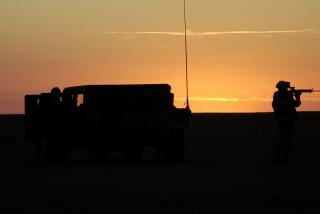Soviet Ghosts Haunt Desolate Somali Outpost : Relief: Surrounded by wreckage of MIGs, 12 lonely Marines listen to Jimi Hendrix and wait for reinforcements to arrive.
- Share via
BELA DOGLE, Somalia — A deserted, tumbledown airport where long-abandoned Soviet fighter jets repose like rotting carcasses is quickly becoming a bustling frontier outpost to bring food into the famished heartland of Somalia.
A major push began Saturday to send more troops and supplies to bolster a smaller force that seized the airport last Sunday, the first conquest in the effort to establish an inland network of bases.
Thousands of military personnel and aircraft will converge here, and a band of 12 filthy Marines who have braved crawling creatures and nightly sounds of sniper fire and ghostly winds will be glad for the company.
Although U.S. and Canadian troops currently secure the sprawling airport’s periphery, for nearly a week now the Marines have camped alone in the eerie center of this densely overgrown Fort Apache.
“It sucks; it’s hot and dirty,” said Cpl. Kenneth Kaighu, who has worn his dust-caked desert camouflage for a week of often 100-degree temperatures.
The heat isn’t the only bad news in the neighborhood.
“A millipede about a foot long got in the tent. I chopped it in half and it just kept moving,” Kaighu said.
These Marines, from bases in Southern California and Arizona, survive their isolation by dreaming of home, rocking out to Metallica and Jimi Hendrix on their radio headsets, and by being one another’s close companions.
“We are basically all on our own here,” said the group’s young leader, Sgt. Michael Hess, from Twentynine Palms. “I just miss home.”
Home seems like planets away. The air base is even a bouncy 60-mile ride from Mogadishu, past flat green countryside, obedient animal herds, scavenged vehicles and stick people.
The base itself has been warped by brutal weather and neglect.
Once, when Somalia was a client of the Soviet Union, MIG fighters soared from here. Now a cavernous, roofless hangar sits amid the high brush, the bare steel beams exposed, aviation parts strewn around two butchered jets.
Nearby, earthen revetments hold the silver metal remains of decaying planes, most reduced to large sections dotted with bullet holes.
What happened here isn’t entirely clear to the American newcomers, but it’s presumed the aircraft--whose cockpits contain both Chinese and American markings--were junked when Somalia dropped from the Soviets’ orbit and allied itself with the United States.
“When Somalia fell out of the Soviet camp, that dried up the supplies of parts” to maintain the planes, said Marine Lt. Col. Fred Peck.
It’s believed the MIGs have been here since the 1970s or perhaps the early 1980s.
Now, the multinational humanitarian effort is thankful for the airport, a key staging area for food distribution.
“It’s going to be a central hub in a wheel,” Peck said.
The once-lethal weapons stand like harmless stage props, almost gargoyle ornaments to remind the Marines just how foreign an experience can get.
They have tried to make their community of three sagging tents and a latrine as homey as possible, given the constraints on tasteful interior decoration.
Tent poles are adorned with a rusted Soviet helmet and the bleached skulls of some unfortunate camels and a hog.
Late in the week, the Marines were joined by a female Navy corpsman, Jennifer Calhoun, or “Doc.”
“Doc brought some Christmas lights. We’re thinking of putting them up on the tent. We’re trying to make this home,” said Lance Cpl. William Hogbin of Yuma, Ariz. The lights would be powered by generator.
Although some Marines describe their digs as tolerable, they won’t look back on this time with syrupy sentiment.
“All you hear are crazy noises out here,” Hogbin said.
In the visible realm, scorpions, millipedes and spiders rank last in the popularity contest here.
“It was a big-ass spider,” said Lance Cpl. Wayne Hinrich of Tustin. “It was dark out, about 8:30, and I saw it walking around. I stomped him. I’m not really that partial to bugs.”
And the camp is surrounded by saber-needled acacia trees.
“There are thorn bushes everywhere; they’ll rip you all to hell,” Kaighu said.
Dealing with boredom--or a case of the willies--is a matter of psychological attitude.
Lance Cpl. James Bankston is comforted by his rifle and 120 rounds of ammunition.
“It ain’t that bad when you have rounds,” he said confidently.
But these Marines aren’t primarily combat troops. They are attached to Marine air wing support units that will service the aircraft operating from here.
The camp sentry, Lance Cpl. Jeffrey Staines, who protects the compound wearing his helmet, heavy flak jacket and carrying an M-16, relies on his imagination to get him through the night.
“I think of home,” he said. “I see me at the beach in summer and having a new car from all the money I’m going to save from here.”
The Marines’ spirits improved when Calhoun arrived to bandage their cuts and remind them to drink seven to 10 liters of water a day.
“They treat me like one of the guys. They look out for me,” she said.
Despite the camaraderie, the Marines want their Somalia expedition to end soon.
“We just hope when we come back home people will still be there for us,” Kaighu said.
More to Read
Sign up for Essential California
The most important California stories and recommendations in your inbox every morning.
You may occasionally receive promotional content from the Los Angeles Times.













